Boxers in the ring speak to each other with their fists and their bodies, with grunts and raised eyebrows and thrust-out chins and weird smiles curling over mouth guards. When the bell is struck to open a round, the universe collapses with a “whoosh” into a luminous cube pulsing with motion and the shouts of the crowd, the canvas slick with sweat and blood and mucus, the fighters illuminated with halos.
With the first ring of the bell, Sadam “World Kid” Ali and “Smokin’” Jay Krupp plunge into each other with abandon. It’s September 30, and Sadam — a 25-year-old welterweight born and raised in Canarsie — is showing his stuff for the first time since his June signing with Golden Boy Promotions, the promotional company of ten-time world champion boxer Oscar De La Hoya. The 30-year-old Krupp — originally from New Orleans and currently living in Catskill, N.Y. — is intended as a warm-up for Sadam. He moves about the ring with the heavy gait of a man with something to prove.
But for someone who’s never lost a professional fight, Sadam looks jittery. He comes out too strong, too hard, overcommitting to punches and slipping on the canvas. At the very end of the first round, Krupp catches Sadam off-balance, landing a strong punch right on the younger boxer’s chin. For the first time in his professional career, Sadam hits the mat.
Sadam, like so many New York boxers, is the son of immigrants. His father, Mahmoud, moved from Yemen to the United States when he was a child. (The family settled in Brooklyn, in Bedford-Stuyvesant). Mahmoud, who now works as a real estate agent, sports a moustache and thinning, combed-over hair. He is a quiet man, soft-spoken, but he chuckles when asked questions the answers to which he thinks should be obvious.
“This is the best country in the world,” he told me over the phone. “This is the only country that you see all religions, all kinds of people. Who doesn’t want to come to the United States?”
According to the 2010 census, upwards of 36,000 Brooklynites claim Arab descent (the Arab American Association of New York estimates that the number of Arabs and Arab Americans in the borough is closer to 117,000). Like many of the borough’s immigrant groups, they have tended to settle in enclaves, in neighborhoods like Downtown Brooklyn and Bay Ridge. But Mahmoud wanted something different for his family. In 1988, he and his wife settled their family in Canarsie. “Canarsie is a mixed neighborhood,” Mahmoud says. “That’s the neighborhood you want to live in.” That’s where Sadam grew up and the Ali family still lives. The people of Canarsie love having a successful boxer in their midst. “Sadam fits in in any community. Everybody loves him — Canarsie or anywhere,” Mahmoud said. “We fit in in any neighborhood. We fit in anywhere.”
The Ali family is a family of women — when Sadam was very young, his father was the only other man in the house. He spent his early days playing with his sisters and female cousins, watched over by his mother and grandmother. “I never got to hang out with any guys,” Sadam said, grinning widely. “I would always play girl games: pitty-pat and patty-cake.”
Mahmoud worried about his son not spending enough time with other men; one day, when Sadam was four years old, he found his son wearing his sisters’ clothing. “My dad was like, “I gotta take him to a man’s sport,’” Sadam said, laughing. Mahmoud began taking his son straight from school to karate class; on weekends, he had both karate and gymnastics. When he was eight, inspired by Yemeni-British boxer “Prince” Naseem Hamed, Sadam asked his father if he could start boxing.
(Hamed, who was known for his flamboyant personality and theatrical entrances, which on at least one occasion involved being carried on a palanquin, has remained an influence on Sadam. Hamed’s sense of showmanship is also apparent in Ali’s fight game — if balanced with a somewhat greater degree of humility. Hamed was also very public about his Muslim faith, frequently invoking the Takbir — an Arabic noun denoting the phrase “Allahu akbar!” or “God is great” — in the ring.) Enthralled by Hamed’s flips into the ring over the ropes and his electric dance moves, Sadam had dreams of boxing glory. Mahmoud, who had seen the pleasure his son took from fighting in karate classes, said the boy could fight. Sadam began training at the New Bed-Stuy Boxing Center. “That’s the best thing to happen to my life, man,” Sadam said. “It just naturally came in me. I mean, I wasn’t good when I first started, but now it’s just naturally in me.”
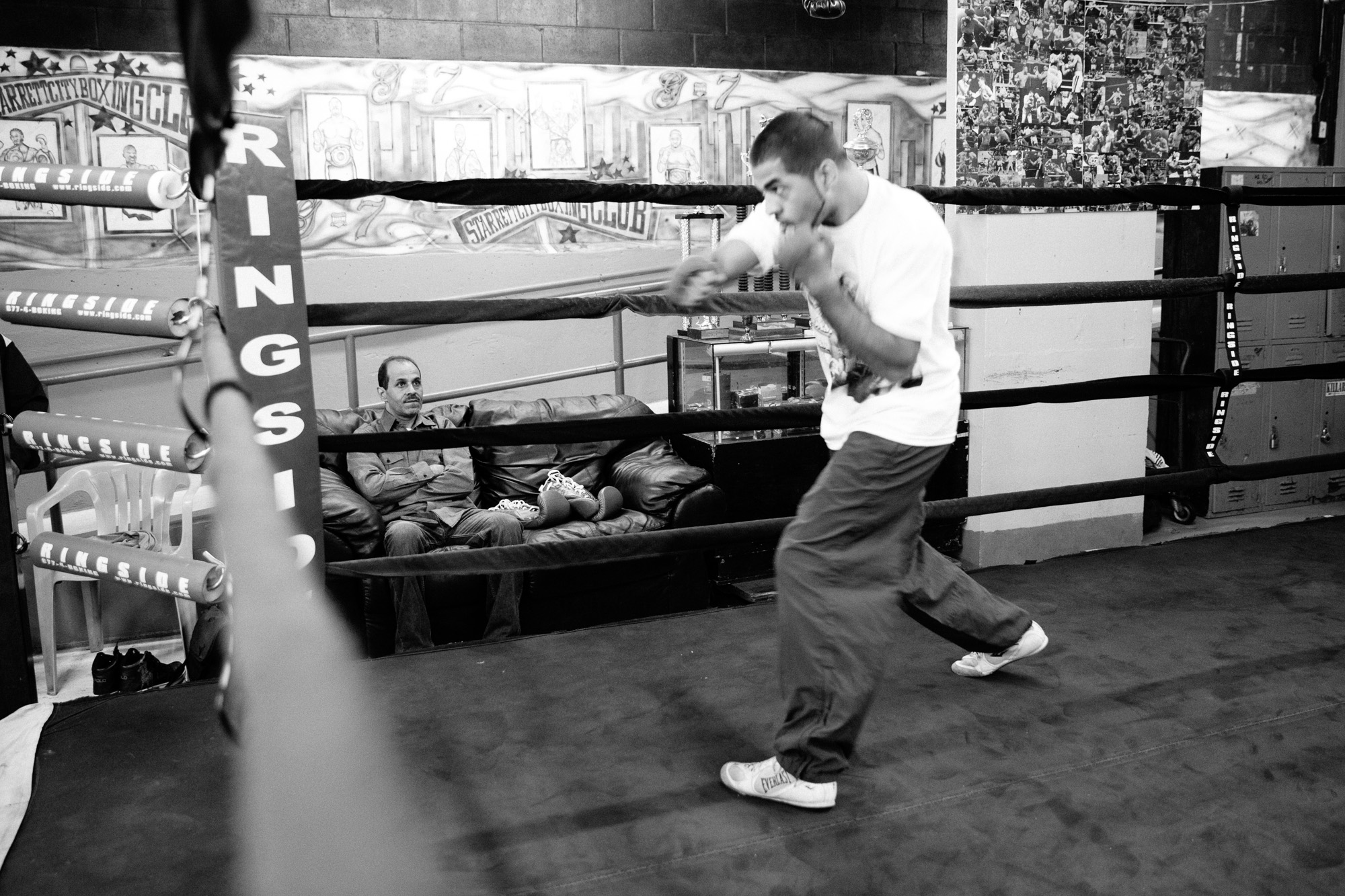
Boxing requires an inhuman amount of drive and discipline — a lot to ask of a child of eight. From the beginning, Mahmoud was a driving force behind his his son’s career. Sadam owes his career to his father: almost every moment of his life has been planned out in advance, the logistics coordinated and planned by Mahmoud. Many adolescents might have chafed under such conditions, but not Sadam. “There’s different types of fathers in the boxing world,” Sadam said. “There are fathers that make the boxer hate boxing. My dad is the type of dad that made me love boxing.”
“It all depends on what you do in the beginning with your kid,” said Mahmoud. “If you let ‘em fly and do things they shouldn’t be doing or be somewhere they shouldn’t be that you don’t know about, and you continue letting it happen — and I know kids like that — it becomes hard for you to try to bring them back. But once you set the foundation, raising them the right way and keeping them from where they’re not supposed to be — it becomes easy. It was so easy. I had no problem with Sadam at all.”
To this day, Mahmoud still attends nearly every workout, every training session. He watches his son with pride, mostly letting Sadam’s coaches critique him but offering quiet words of advice and encouragement as he wraps his son’s hands or offers him water. Sadam’s mother, on the other hand, has never seen him fight. Even when the rest of the Ali family gathers to watch a televised bout, she covers her face, unable to watch her son’s handsome face get knocked in, the flesh around his big brown eyes swollen and bruised. She has never wanted him to fight, but it makes him happy.
Thanks to his family — especially Mahmoud — boxing is the only job Sadam has ever had. Such involvement, however necessary, comes with a price. “You take off work. You sacrifice a lot of things,” Mahmoud told me. He is, understandably, tired. He and his son have traveled to over 200 amateur fights together around the country and even internationally. His younger son Adam, who is now five, will not receive nearly so much attention. “It’s impossible. It’s too much!” Mahmoud said, laughing. “It’s too much traveling, it’s too much work.
“Adam is going to have to find his own way. I’ll help him out a little bit, but I’m not going to be able to do for him what I did for Sadam.”
One of Sadam’s sparring partners is Frank Galarza — a 27-year-old Puerto Rican–American light middleweight out of Red Hook who now lives in East New York, adjacent to Ali’s Canarsie. Galarza comes from a very different world from Sadam’s. Galarza’s father, himself a one-time boxer, died of a gunshot wound when Frank was seven. Galarza’s mother overdosed when he was nine. He discovered boxing at seventeen and showed promise, but the pressures of life on the street proved too much to bear. “Yeah, well, I’ve been out there, man,” Frank said when asked what motivates his current success. (He is currently undefeated as well.) After seven years of drugs and violence, he said, “I realized that I needed to make a change, or I was going to die.”
There are countless stories of boxers, like Frank Galarza, who have had to fight through life outside the ring. Sadam doesn’t fit this mold — his family was stable and supportive of his career. But he’s still had to beat the odds to get where he is. It’s not easy being a young Arab American, particularly a young man, in America today. Everywhere, on every street, there is the possibility of being profiled based on appearances. “An entire generation of Muslim Arab Americans has never known an adult experience where 9/11 was not somewhere in the backdrop,” Anna Fifield wrote in the Financial Times. Fifield also reported that a quarter of Arab Americans report moderate to severe anxiety as a result of racial profiling.
The scrutiny applied to New York’s Arab and Muslim communities by the NYPD has taken on a particularly Orwellian intensity, as recently documented by Matt Apuzzo and Adam Goldman in a New York magazine story on the department’s “Demographics Unit,” a secret police squad tasked with anti-terrorism intelligence-gathering. Apuzzo and Goldman’s revelations, however, were not news to anyone on the receiving end of these practices. In his 2008 book, How Does It Feel To Be A Problem?, Moustafa Bayoumi, an associate professor of English at Brooklyn College, alludes to a phenomenon in which young Arab Americans change their names to pass as Latino and Latina. Sadam, however, would never consider such radical action — he likes his name because it sticks in people’s minds. “I wouldn’t change my name for the world,” he told Fifield. “You shouldn’t be judged on your name.” (Frank Sinatra’s father, Anthony Martin Sinatra, a boxer, fought under the name Marty O’Brien.)
“We’re normal Muslim Americans,” Mahmoud told me. “We fast on Ramadan; we pray; that’s about it.”
When asked, Mahmoud insisted that neither he, Sadam, nor anyone else has ever had a problem with the police. “Nothing at all,” he said. “It’s been great. Perfect. No problem, nothing. No problem at all, 100 percent.” He was very adamant on this point: “I’ve never had a problem, Sadam has never had a problem. Sadam is a wonderful person. Everyone likes him.”
“I’m just a humble guy,” Sadam said in a separate interview. “I’m just nice to everybody. I’m cool with everybody.”
(Sadam did allude, in a roundabout way, to one way he’s been on the outside: “A lot of people underestimated me because I was Arabic,” he said. “There’s not too many Arab boxers out there that are good. Nobody thought I would make the Olympics for Team USA” — which he did. But that’s the most he, or his father, will offer on their experience as Arab Americans.)
“Any other question you ask me about that, my answer is that I’ve never had a bad experience,” Mahmoud said. “It’s been beautiful.”
“I’d like to keep it to boxing,” he concluded.
By the third round Sadam has begun to dictate the tempo of things. Krupp moves awkwardly around the ring, his movements all the more stuttering in comparison to the effortless grace Sadam finds once he settles down, as if having been buoyed by getting clocked in the jaw. With around a minute left in the third round. Krupp swings wildly at Sadam, coming off the ropes, and Sadam meets him with a glancing overhand right followed by a strong left hook, the latter straight to Krupp’s chin. Krupp crumples to the canvas. Smelling blood, Sadam spends the rest of the round chasing a wobbly-looking Krupp around the ring, trying to line up and land power punches but mostly missing.
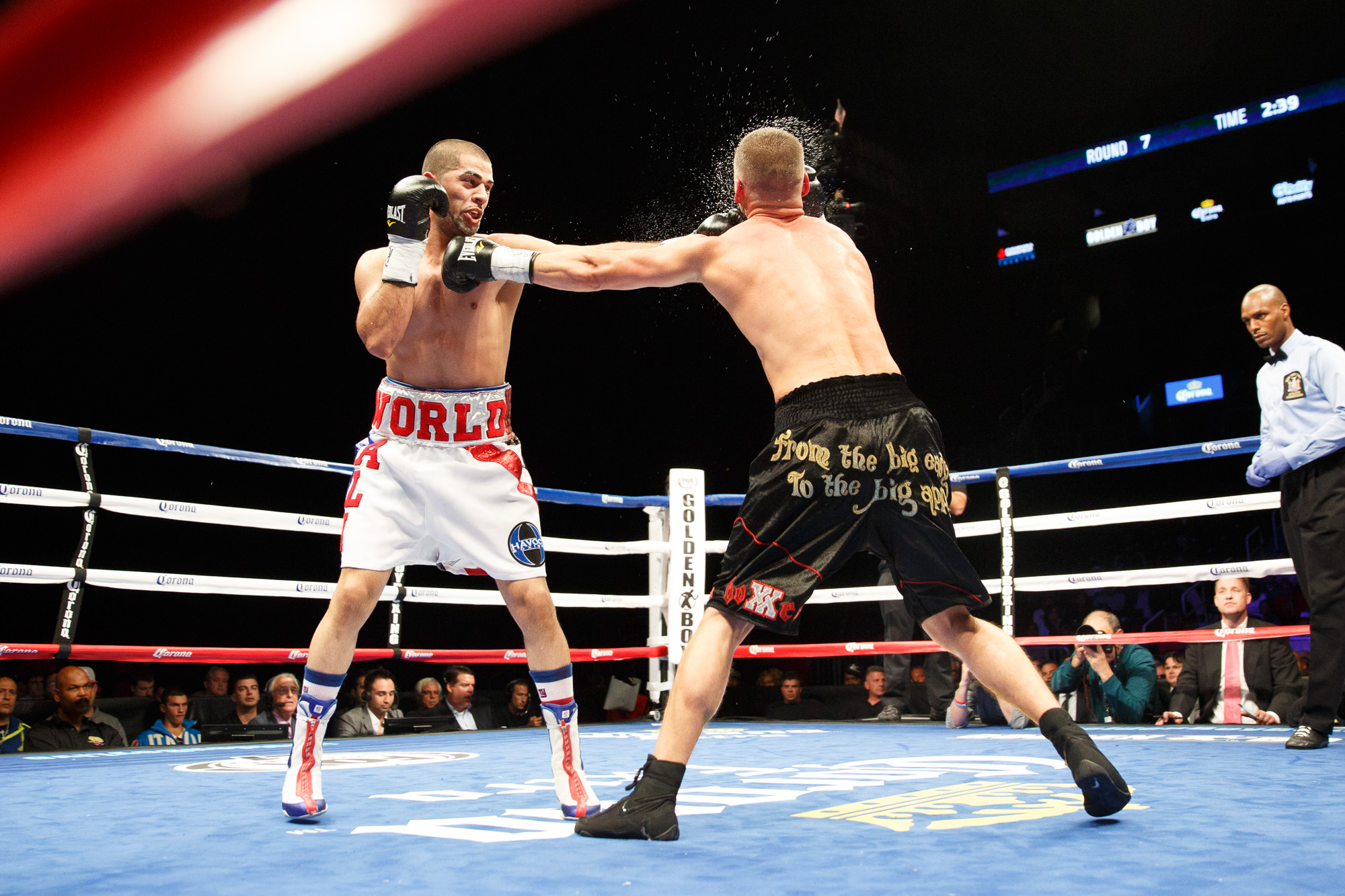
The bell rings, and Krupp goes to his corner. He’s clearly shaken, lucky to have avoided being knocked down again or even out completely. Sadam also returns to his corner. He’s dominating the fight, but he's just missed a chance to wear Krupp down with body shots. It’s a long fight, and patience matters.
Andre Rozier and Leonard Wilson, Sadam’s trainers, simply sound exasperated. “The jab does everything, Sadam,” Rozier shouts. “It’s a pretty jab. I’d like to see more.”
“Ali ain't shit!” Krupp’s coach shouts into his fighter’s battered face.
Maybe the miscalculation is Sadam showing a little rust. It’s been almost a year since his last fight, and this wasn’t an easy bout to train for. Ramadan had barely ended when the fight was announced. He’d been expecting to have until late October to prepare for the fight. Instead, he began training during the sacred month. From July 10 to August 7, Sadam did not eat or drink during daylight hours but continued working out. Even taking things easy — running every day, sticking to body weight exercises — preparations were brutal.
When I first met Sadam at Starrett City Boxing Club, with six weeks to go before his fight, we still didn’t know who he would be fighting — but the young boxer shrugged this off with a smile. “Whenever I get in the ring, all I need is 45 seconds to a minute to figure out what type of fighter this guy is,” he told me. Sadam prides himself on his ability to adapt in any given situation, to recognize his opponents’ weaknesses and exploit them. “I can actually tell from the way he bounces on the corner whether he’s gonna come at me and throw punches or whether he’s gonna be a mover.”
“I can come brawl and take it straight to you, or I can move. I can be the slick guy who throws one punch and then goes up under and makes you miss. I do it all.”
“It’s a boxing thing, man,” Sadam said. “Not everybody has that.”
Hardly had he taken a sip of water before shouts of “Sadam! Let’s go!” rang out and he was summoned back into the ring or to the heavy bag. Spectators often do not truly appreciate the extreme level conditioning boxers are required to maintain. To go even one or two rounds, said Frank Lanza, a 79-year-old Bronx native who hangs around boxing gyms, seems easy. “But if you’re not in shape, holding your hands up high — they’re like bricks on your arms.” Indeed, the first time I watched Sadam spar, three weeks after Ramadan ended, I was surprised — he looked slower than the fighter I’d seen on YouTube.
“We’re working off the rust,” Sadam’s longtime coach Andre Rozier told me with a wave of his hand. Rozier is a big man, maybe six-three or six-four. He’s been training fighters at Starrett City for more than 30 years, underneath a parking garage in East New York’s Spring Creek Towers. (He also personally designs and sews his fighters’ shorts and jackets.)
Sadam met Rozier when he was twelve. Early in their relationship, Rozier told Sadam to go one more round on a heavy bag, and Sadam said no. Rozier stepped close to the twelve-year-old boy and snarled, “Nobody tells me ‘no,’” before picking up two dumb-bells and shoving them into Sadam’s chest.
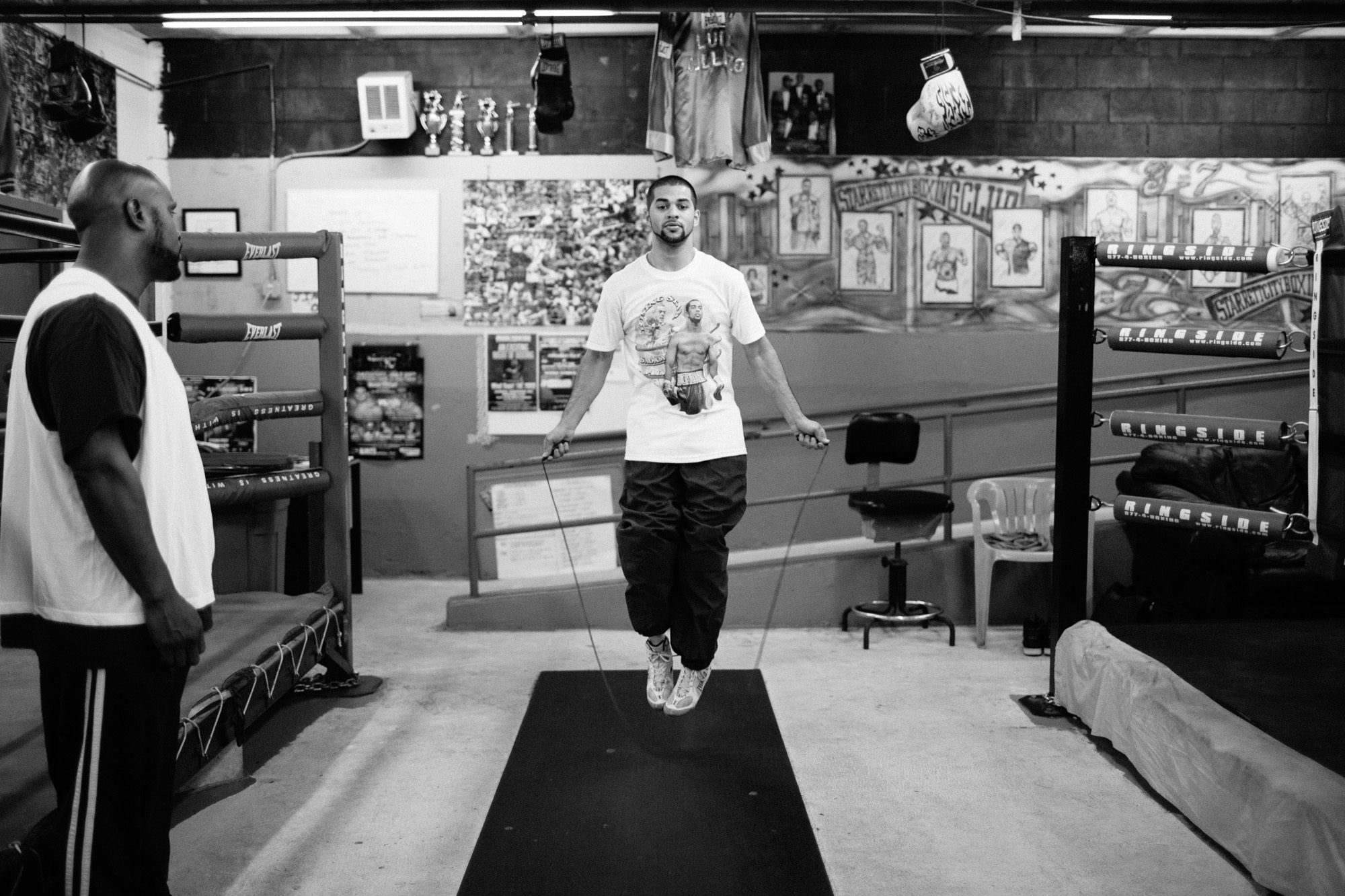
“Two hundred jumping jacks,” he demanded. “Go.”
Sadam looked over to his father. So did Andre. Mahmoud looked back at them both, smiled, and turned away. Remembering the subsequent look of terror on Sadam’s face, Rozier cackles. “He thought his father was going to help him!”
After 150 jumping jacks, dumbbell in each hand, Andre told Sadam to stop. “Are you ever going to tell me ‘no’ again?” he asked. Sadam shook his head.
“Good,” said Andre. “Now. Two more rounds.”
Andre told me this story as Sadam worked the speed bag. Sadam watched us, pausing to interject before Andre shouted, without turning around, “Keep going!”
Another one of Sadam’s sparring partners, a southpaw, grabbed him between sets on the heavy bag and asked for a picture. Sadam was happy to oblige, while Andre scowled and shouted at him to get back to work. He grabbed Sadam away from the hanging bag and shoved him toward one set against the wall. Sadam bounced back and forth from the ball of one foot to the other. He tapped the bag lightly every so often and raised his eyebrows as if to say, “What? I’m working.” The other fighters smirked at Sadam’s display of feigned insolence.
Suddenly Andre sang out in a strong, clear voice, to the tune of Lou Rawls’s “You’ll Never Find Another Love Like Mine”: “You’ll never find, / No matter where you search, / Someone as lazy as Sadam.”
Sadam thundered a few left hooks into the wall. They echoed around the cramped gym, and Andre kept singing.
Boxing in New York City is not what it once was. (Madison Square Garden hosted only two fights in 2012 and two in 2011.) The demolition of Ebbets Field — the site of many title fights in the first part of the century — in 1960 was a big blow to boxing in the city. But the major force behind boxing’s decline in New York has been the shadow cast over the city by places like Las Vegas. Casinos in Vegas and elsewhere are able to subsidize fights with gambling profits and keep costs low as a result of looser labor regulations. Boxing fans hope that the presence of the Barclays Center, the city’s second major arena, will motivate both venues to figure out more cost-effective ways to put on shows.
Fans are also looking to Golden Boy to reinvigorate the city’s pugilistic culture, investing in fighters and gyms along the way. Currently, the promotional company, which is based out of Los Angeles, is working with Barclays’ operations partner Brooklyn Sports and Entertainment to arrange and promote fights at the arena.
Lanza, who fought in both the 1952 and 1953 New York Golden Gloves tournaments (1953 was the last year the amateur tournament was conducted without mandating that the fighters wear head gear), says he’s pleased with what Barclays has done for the sport so far — even if it’s just prompting Madison Square Garden to get its act together. “They redid the garden last month,” he said. (MSG completed a $1 billion renovation in October.) “They needed a little ‘oomph’ in there.” For his part, Sadam was excited to fight on such a big stage in front of a home crowd — in the borough that produced Floyd Patterson, Mike Tyson, and Riddick Bowe. “It’s so big; it’s so beautiful,” he said after training one day. “It’s in Brooklyn!”
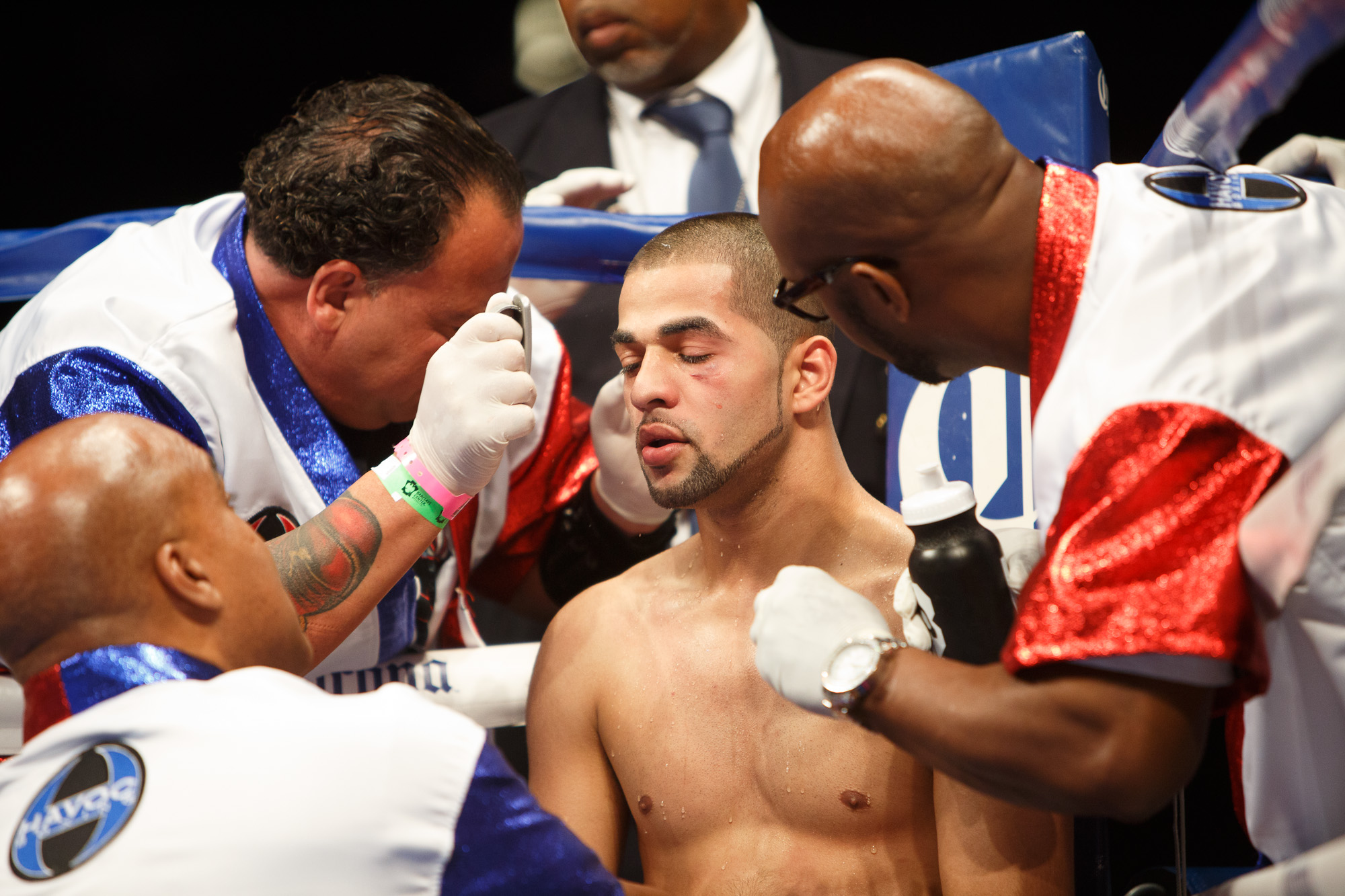
The bout with Krupp is the first rung on the ladder to a belt. “The next step for him is to try to move up the ladder with a little bit of competition,” Lanza said. Golden Boy, which also represents Floyd Mayweather, is in the business of grooming champions. “They’re trying to find an opponent that’s not over his head,” Lanza said. “You don’t want to rush him. That’s no good either. Gotta look out for his protection.”
Sadam has spent most of his life working for the opportunity to be in this position. In high school, between winning back-to-back National Golden Glove championships as a 125-pound featherweight in 2006 and as a 132-pound lightweight in 2007, Sadam won bronze for the United States at the 2006 Junior World Championships in Agadir, Morocco. Two years later he represented the United States at the 2008 Beijing Olympics — the first Arab American to ever qualify for the U.S. Olympic team, and the first New York boxer to qualify in over 20 years.
Mahmoud told me that while he worried for his son in those early years, he is able to enjoy himself a bit more now.
“You get that little bit of nervousness at the beginning, but everybody’s got that,” he said. “Even the fighters. There’s no fighter that’s gonna step in the ring and he’s not a little nervous. A lot of fighters will tell you, ‘I’m not nervous! I’m ready!’”
He laughed.
“That’s a lie. There’s no way in the world any fighter is gonna step in the ring and not be nervous. Every fighter gotta be nervous.”
He paused.
“Everybody gotta be nervous.”
There are some fighters who step in the ring because they are looking to hurt people; the Bed-Stuy–born and Brownsville-raised Mike Tyson was notorious for his sense of raw violence, in the ring and out of it. “When I fight someone, I want to break his will. I want to take his manhood,” Tyson told Sports Illustrated back in 1988. “I want to rip out his heart and show it to him.” (As it happens, Krupp trains with Tyson’s former coach, Kevin Rooney.)
Such fighters appease the crowd’s basest instincts, as the crowd is not a loyal thing. The crowd at a boxing match cheers its fighter when he steps into the ring and when the first bell rings and when he moves well and looks strong, but the honest truth is that most people just want to see blood — the crowd doesn’t care who wins so long as someone loses. To attend a boxing match is to feel a shimmer of the human bloodlust that for hundreds of years drove the ancient Romans to watch gladiators hack away at each other.
In the fight immediately preceding Sadam’s, something like hate peered out from behind light welterweight Miguel Zuniga’s eyes at his opponent, Michael Perez. No matter how many punches Perez landed, Zuniga just kept coming, drawn onward as if by some some brutal magnet. After eight rounds, the two fighters looking like something you’d find hanging from hooks in a walk-in freezer, the referee raised Perez’s fist above his head, and the crowd clapped respectfully. The crowd’s disappointment at the lack of a more brutal conclusion was palpable.
Cheers of “Ali! Ali! Ali!” spring up intermittently during Sadam’s fight — one attendee vainly attempts to raise the crowd’s voice in a chant of “Ali, bumaye!” (“Ali, kill him!”) as those in Zaire did at the Rumble in the Jungle. The crowd is obviously strongly in favor of the Canarsie boxer, but every time Krupp counters a combination that brings Sadam in too close with an explosion of counter-punches, there is a sense of bloodthirsty anticipation.
Over the course of the fight, one can see Sadam adjusting his tactics: coming on strong here, backing off there, goading Krupp into overreaching, drawing him close. He’s figuring it out as he goes along, assessing situations and adapting accordingly, conducting himself in whatever way he needs to. From round to round, Sadam lets Krupp lurch around the ring, alternately chasing and being chased. With about a minute left in the fight — both fighters bloody and bruised — Krupp swings wildly at Sadam, landing a few body shots. With 20 seconds left, he keeps coming, only to be lured into throwing an ill-timed, off-balance jab that Sadam meets with a powerful right hook, sending Krupp to his knees.
Sadam skips away to a neutral corner, nodding dramatically at the roaring crowd as Krupp staggers to his feet. Sadam and Krupp will hammer away at each other for a few more seconds, but the fight is over with that second knockdown. Sadam is the winner by unanimous decision. “He’s a desperate type of fighter,” Sadam says of Krupp after the fight. There is nothing desperate about Sadam. The “World Kid” moniker is an apt one for the son of immigrants, who laughs as he brawls — Sadam Ali, the handsome boxer, who fights viciously but without bitterness or malice. Then again, as Floyd Patterson once told Gay Talese, “It’s in defeat that a man reveals himself.” But Patterson was a broken man when he spoke to Talese, and Sadam is only growing stronger.
Despite Sadam’s victory, Frank Lanza worries that Sadam may have been having a little too much fun in the ring. “He’s a little lackadaisical,” he told me. “He’s a young fella, so we’ll see how it turns out.” Down the road, Lanza says, Sadam may have a shot at a title. “Two or three years,” he said. “Maybe three.”
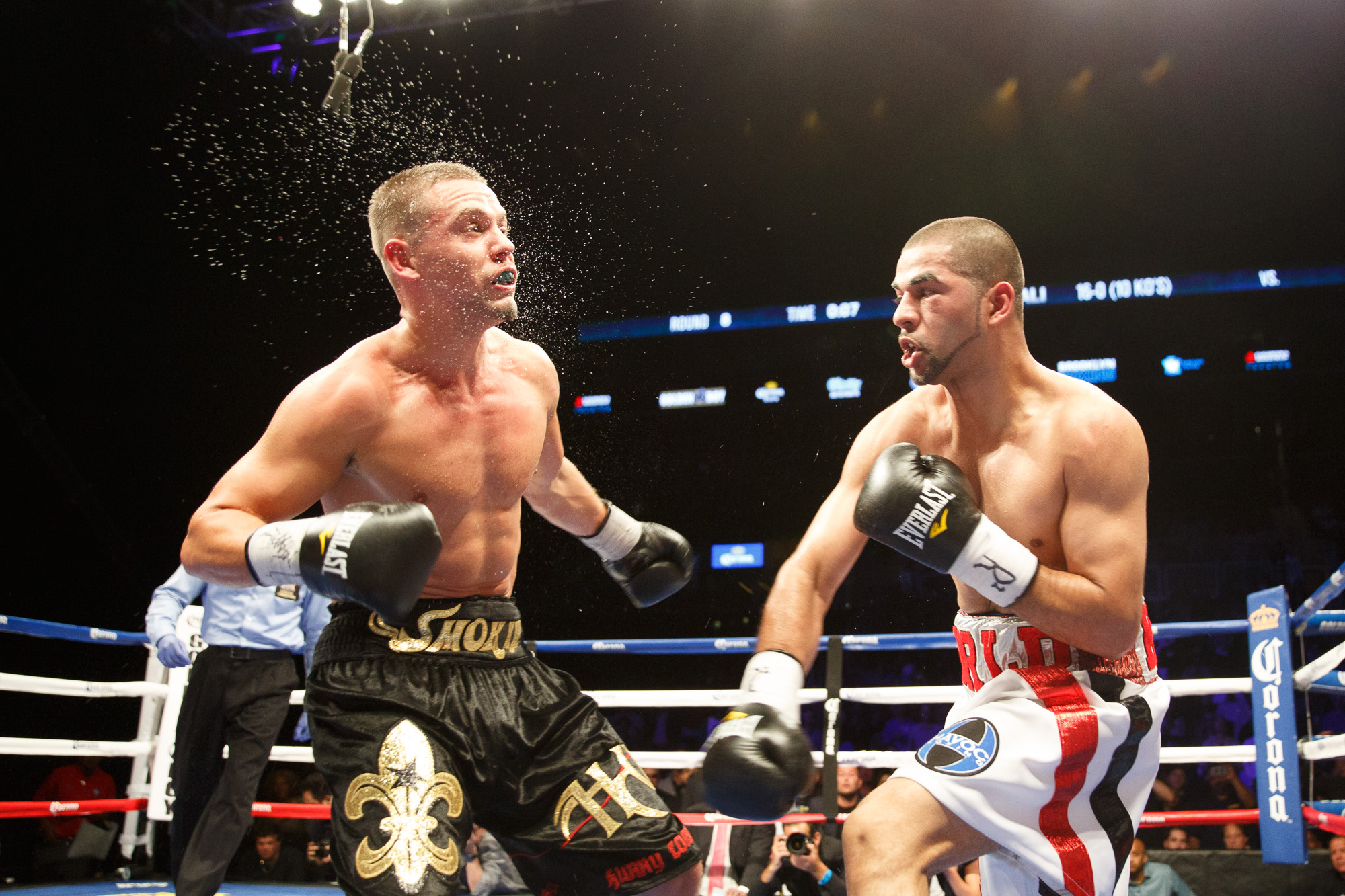
When Sadam went down in the very first round, there was a part of the crowd that wanted to see him crumple completely. It’s hard not to root against someone who hasn’t been beaten. And who could have blamed him if he had — 25-year-old undefeated former Olympian fighting in front of a home crowd gets knocked down for the first time in years? But he sprang to his feet, and deep in his eyes, there was something like crazed joy. It takes a wild kind of playfulness to get punched in the face and to smile — but that is exactly what Sadam did. “That’s boxing, Sadam!” Andre shouted. Mahmoud looked on. We might as well have been back at Starrett City.